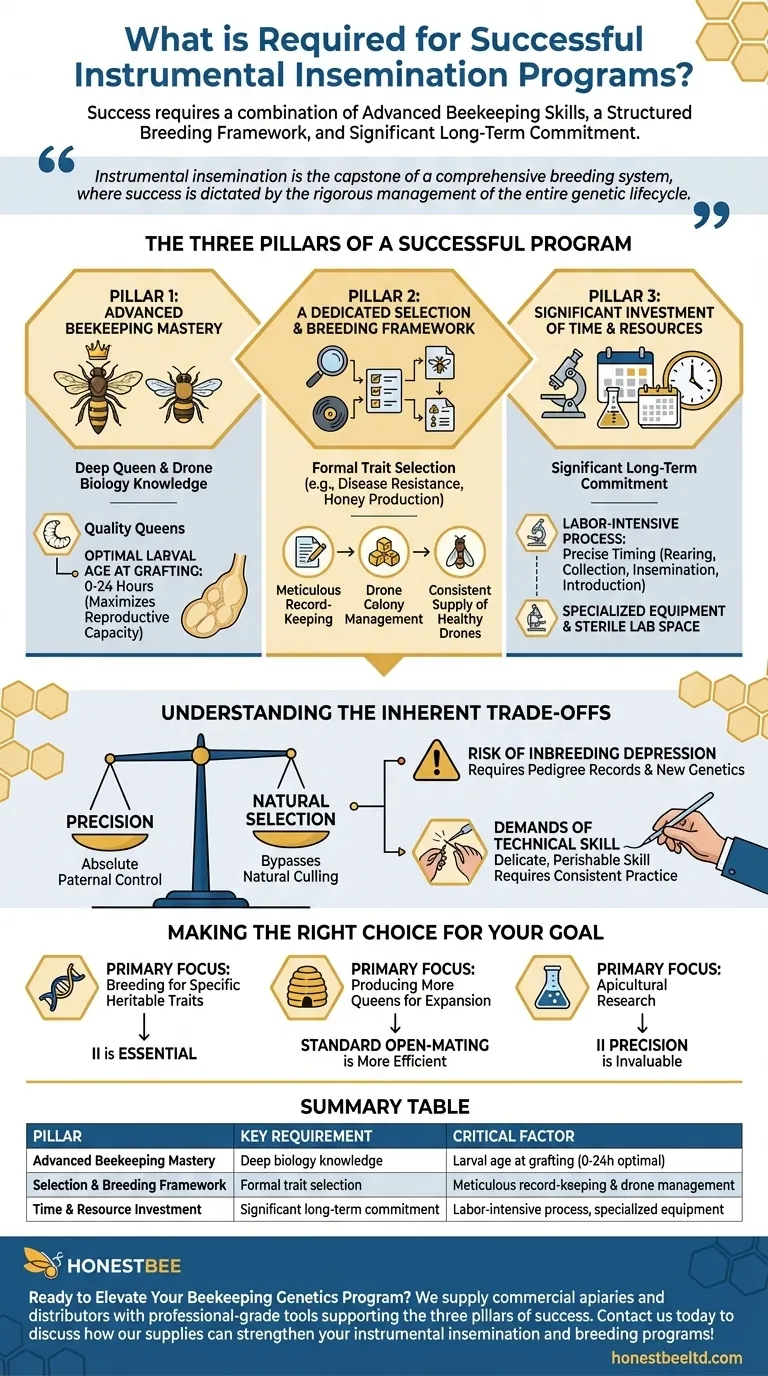To succeed with instrumental insemination, you must combine three critical elements: advanced beekeeping and queen-rearing skills, the resources for a structured selection and breeding program, and a significant long-term commitment. This is not a casual undertaking; it is a demanding, labor-intensive, and expensive process designed for serious genetic improvement.
Instrumental insemination is not merely a technical procedure for creating queens. It is the capstone of a comprehensive breeding system, where success is dictated by the rigorous management of the entire genetic lifecycle, not just the final act of insemination.

The Three Pillars of a Successful Program
Success in instrumental insemination (II) rests on a foundation of three distinct but interconnected requirements. Neglecting any one of these pillars will undermine the entire effort, regardless of your skill with the insemination equipment itself.
Pillar 1: Advanced Beekeeping Mastery
This goes far beyond standard apiary management. A successful program requires a deep, practical understanding of queen and drone biology to produce high-quality reproductive individuals on a precise schedule.
The quality of the queen is paramount. Queens must be reared under optimal conditions to ensure they are physiologically prepared for insemination and egg-laying.
For example, larval age at grafting directly impacts reproductive capacity. Queens reared from younger larvae (ideally 0-24 hours post-hatch) develop larger ovaries and spermathecae, making them better candidates for a successful insemination.
Pillar 2: A Dedicated Selection & Breeding Framework
Instrumental insemination is a tool, not a goal. Its purpose is to control genetics. Without a formal program to select for desired traits, the tool has no purpose.
You must identify the specific traits you wish to propagate, such as disease resistance, honey production, or temperament. This requires meticulous record-keeping and objective evaluation of colony performance over multiple generations.
This framework also applies to drones. Drone-producing colonies must be managed with the same care as queen-rearing colonies to ensure a consistent supply of mature, healthy drones for semen collection.
Pillar 3: Significant Investment of Time & Resources
The commitment required is substantial and ongoing. The initial investment in equipment—microscopes, insemination devices, and sterile lab space—is only the beginning.
The process is labor-intensive, involving the precise timing of queen rearing, drone collection, semen handling, the insemination procedure itself, and careful introduction of inseminated queens back into colonies.
This is a long-term endeavor. Seeing tangible genetic progress can take years of consistent effort, data collection, and refinement.
Understanding the Inherent Trade-offs
While offering unparalleled control, instrumental insemination introduces unique challenges and responsibilities that are absent in natural mating.
Precision vs. Natural Selection
With II, you have absolute control over the paternal lineage of your queens. This is its greatest strength.
However, you also bypass the natural selection that occurs during mating flights. Weaker drones and queens are naturally culled from the gene pool, a quality-control check that you must now perform yourself through rigorous selection.
The Risk of Inbreeding Depression
A closed breeding program with a limited number of drone lines can quickly reduce genetic diversity. This can lead to inbreeding depression, resulting in poor brood viability and weakened colonies.
Managing this requires careful planning and maintaining detailed pedigree records. You must be prepared to source new genetic material periodically to maintain the health of your stock.
The Demands of Technical Skill
The physical act of insemination is a delicate, perishable skill. It requires steady hands, excellent eyesight, and consistent practice to maintain proficiency and achieve high success rates.
This is not a technique that can be mastered and then performed infrequently. It demands regular use to remain effective, reinforcing the need for a long-term program structure.
Making the Right Choice for Your Goal
Deciding whether to pursue instrumental insemination depends entirely on your objectives.
- If your primary focus is breeding for specific, heritable traits: Instrumental insemination is an essential tool, provided you have the resources to support a full-scale selection program.
- If your primary focus is simply producing more queens for colony expansion: Standard, open-mating queen-rearing methods are far more efficient and cost-effective.
- If your primary focus is apicultural research: The precision and control offered by this technique are invaluable for studying honey bee genetics and reproductive biology.
Ultimately, instrumental insemination succeeds when treated not as a standalone task, but as the engine of a disciplined and long-term breeding strategy.
Summary Table:
| Pillar | Key Requirement | Critical Factor |
|---|---|---|
| Advanced Beekeeping Mastery | Deep queen & drone biology knowledge | Larval age at grafting (0-24 hours optimal) |
| Selection & Breeding Framework | Formal trait selection program | Meticulous record-keeping & drone colony management |
| Time & Resource Investment | Significant long-term commitment | Labor-intensive process requiring specialized equipment |
Ready to Elevate Your Beekeeping Genetics Program?
As HONESTBEE, we supply commercial apiaries and beekeeping equipment distributors with the professional-grade tools needed for successful instrumental insemination programs. Our wholesale-focused operations provide the reliable equipment and supplies that support the three pillars of success: advanced beekeeping mastery, structured breeding frameworks, and long-term genetic improvement commitments.
Contact us today to discuss how our beekeeping supplies and equipment can strengthen your instrumental insemination and breeding programs!
Visual Guide

Related Products
- Professional Dual-End Stainless Steel Hive Tool for Beekeeping
- HONESTBEE Advanced Ergonomic Stainless Steel Hive Tool for Beekeeping
- Professional 3-Bar Frame Grip with Integrated Hive Tool
- Plastic Chinese Queen Grafting Tool for Bee Queen Rearing
- Black 2 Pack Beekeeper Queen Grafting Tool for Bee Queen Larva Transferring Needle
People Also Ask
- How should beekeepers handle bees when using a hive tool? Master Calm, Deliberate Techniques
- What are the features of a regular hive tool? The Essential Multi-Tool for Every Beekeeper
- What should beginners consider when purchasing beekeeping equipment? A Guide to Essential Starter Gear
- What is the hive tool used for? The Essential Multi-Tool for Every Beekeeper
- What are the basic tools for beekeeping? Essential Starter Kit for Safe & Successful Hive Management



















